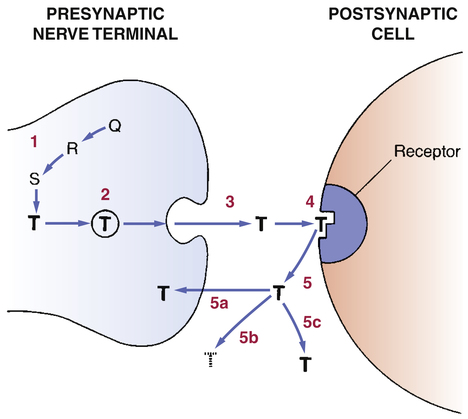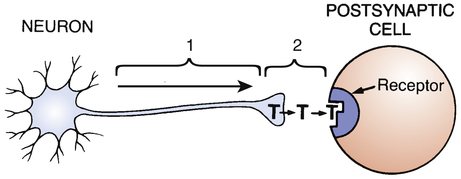CHAPTER 12 Why do we have so many neuropharmacologic drugs? The answer lies in a concept discussed in Chapter 5: Most therapeutic agents act by helping the body help itself. That is, most drugs produce their therapeutic effects by coaxing the body to perform normal processes in a fashion that benefits the patient. Since the nervous system participates in the regulation of practically all bodily processes, practically all bodily processes can be influenced by drugs that alter neuronal regulation. By mimicking or blocking neuronal regulation, neuropharmacologic drugs can modify such diverse processes as skeletal muscle contraction, cardiac output, vascular tone, respiration, GI function, uterine motility, glandular secretion, and functions unique to the CNS, such as ideation, mood, and perception of pain. Given the broad spectrum of processes that neuropharmacologic drugs can alter, and given the potential benefits to be gained by manipulating those processes, it should be no surprise that neuropharmacologic drugs have widespread clinical applications. We begin our study of neuropharmacology by discussing PNS drugs (Chapters 14 through 19), after which we discuss CNS drugs (Chapters 20 through 40). The principal rationale for this order of presentation is that our understanding of PNS pharmacology is much clearer than our understanding of CNS pharmacology. Why? Because the PNS is less complex than the CNS, and more accessible to experimentation. By placing our initial focus on the PNS, we can establish a firm knowledge base in neuropharmacology before proceeding to the less definitive and vastly more complex realm of CNS pharmacology. Figure 12–1 illustrates the basic process by which neurons elicit responses from other cells. The figure depicts two cells: a neuron and a postsynaptic cell. The postsynaptic cell might be another neuron, a muscle cell, or a cell within a secretory gland. As indicated, there are two basic steps—axonal conduction and synaptic transmission—in the process by which the neuron influences the behavior of the postsynaptic cell. Axonal conduction is simply the process of conducting an action potential down the axon of the neuron. Synaptic transmission is the process by which information is carried across the gap between the neuron and the postsynaptic cell. As shown in the figure, synaptic transmission requires the release of neurotransmitter molecules from the axon terminal followed by binding of these molecules to receptors on the postsynaptic cell. As a result of transmitter-receptor binding, a series of events is initiated in the postsynaptic cell, leading to a change in its behavior. The precise nature of the change depends on the identity of the neurotransmitter and the type of cell involved. If the postsynaptic cell is another neuron, it may increase or decrease its firing rate; if the cell is part of a muscle, it may contract or relax; and if the cell is glandular, it may increase or decrease secretion. To understand how drugs alter receptor activity, we must first understand the steps by which synaptic transmission takes place—since it is by modifying these steps that neuropharmacologic drugs influence receptor function. The steps in synaptic transmission are summarized in Figure 12–2.
Basic principles of neuropharmacology
How neurons regulate physiologic processes
Basic mechanisms by which neuropharmacologic agents ACT
Sites of action: axons versus synapses
Steps in synaptic transmission

 Steps in synaptic transmission.
Steps in synaptic transmission.
Step 1, Synthesis of transmitter (T) from precursor molecules (Q, R, and S). Step 2, Storage of transmitter in vesicles. Step 3, Release of transmitter: In response to an action potential, vesicles fuse with the terminal membrane and discharge their contents into the synaptic gap. Step 4, Action at receptor: Transmitter binds (reversibly) to its receptor on the postsynaptic cell, causing a response in that cell. Step 5, Termination of transmission: Transmitter dissociates from its receptor and is then removed from the synaptic gap by (a) reuptake into the nerve terminal, (b) enzymatic degradation, or (c) diffusion away from the gap.
< div class='tao-gold-member'>
![]()
Stay updated, free articles. Join our Telegram channel

Full access? Get Clinical Tree


Basic principles of neuropharmacology
Only gold members can continue reading. Log In or Register to continue
Get Clinical Tree app for offline access


